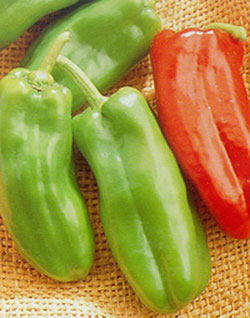Green chiles are actually immature chile peppers, which when left on the plant, ripen and become red chiles.

The spicy and hot taste of a chile depends on how much capsaicin is produced. The variety of chile plant influences this, but so does air temperature and gardening practices, such as fertilizing and watering. Capsaicin is concentrated in the yellow ridges along the inner walls of a chile pepper, where capsaicin pustules form. It is a common mis-conception that the seed of the pepper holds the hot flavor, but this is only true if the capsaicin pustules burst onto them. Hot, dry weather promotes production of capsaicin.
Choose chiles on the basis of pungency. A very mild chile variety is NuMex. Big Jim and 6-4 are chile varieties with a medium bite. For hot chiles consider Sandia or Espanola Improved. For the brave, some very hot varieties are Jalapeno and Cayenne.
Plant chile transplants around the last day of May, or when night temperatures consistently remain above 50 degrees Fahrenheit. It’s best not to plant chile peppers where close plant relatives were grown in the last year. These include tomatoes, eggplant, potatoes and tomatillos. The same diseases that affect these plants will affect chiles and may carry over from year to year.
Space transplants about 24 inches apart and fertilize them with a weak water-soluble fertilizer. Fertilize the chiles again in four weeks. Water chiles regularly through the growing season, but do not overwater, as excessive water can cause root disease, especially in heavy clay soils.
Harvest green chiles when the peppers are firm and a glossy green, usually in August. Green peppers left on the plants will turn entirely red and be ready for harvest by late September.
For more information, see the following Colorado State University Extension fact sheet(s).



